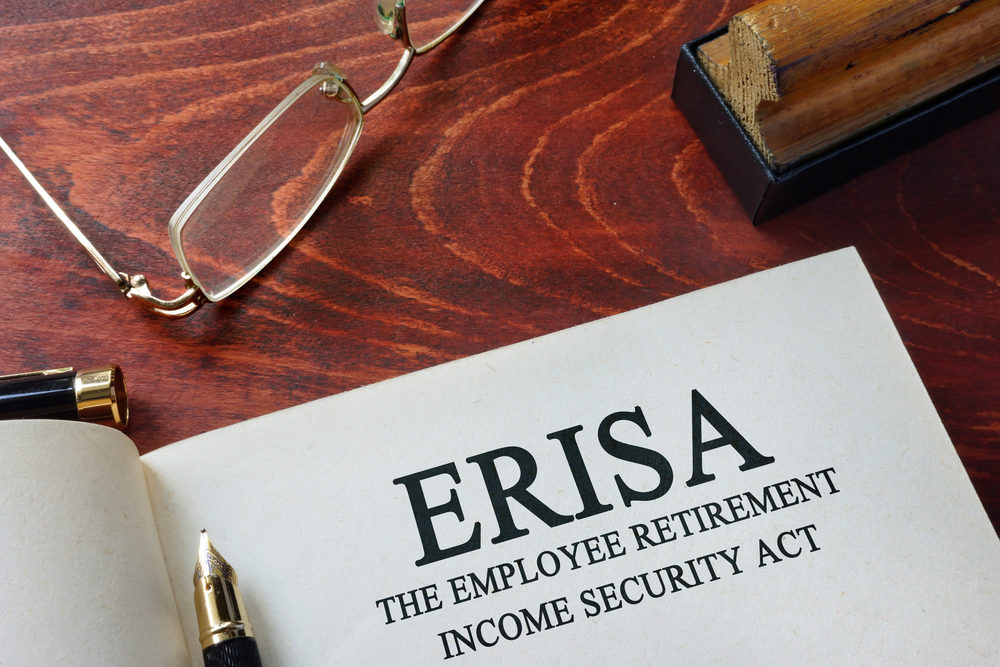
By Jason D. Lazarus, J.D., LL.M., MSCC, CSSC
Although a deep dive into ERISA law and liens is beyond the scope of this article, this will give you an overview and a starting point. The Employee Retirement Income Security Act was passed by Congress and signed into law by President Ford in 1974.[1] According to the U.S. Department of Labor, ERISA “protects the interests of employee benefit plan participants and their beneficiaries. It requires plan sponsors to provide plan information to participants. It establishes standards of conduct for plan managers and other fiduciaries. It establishes enforcement provisions to ensure that plan funds are protected and that qualifying participants receive their benefits, even if a company goes bankrupt.” Many would not agree with that statement when it comes to actually protecting plan participants as it relates to resolution of ERISA liens, but that is the stated purpose.
ERISA governs nearly all employer health plans. The primary exceptions are government employer plans governed by FEHBA and state government or church plans which are governed by state law. Most, if not all, ERISA health insurance plans state that injuries caused by a liable third party are not a covered expense and require reimbursement when a plan pays for injury related medical expenses (often referred to as subrogation clauses). ERISA provides that health plans which qualify under its provisions can bring a civil action under section 502(a)(3) to obtain equitable relief to enforce the terms of the plan. Appropriate equitable relief is really the only enforcement mechanism an ERISA plan can utilize to address its reimbursement rights contained in the plan. While that all may sound simple, ERISA is a “compressive and reticulated statute” which means that the law on this subject is quite complicated.[2] So the Supreme Court has clarified exactly what is appropriate equitable relief under ERISA over the last twenty years.
Starting in 2006, the United States Supreme Court began to clarify and articulate just how powerful a “self-funded” ERISA plan’s recovery rights are under federal law. In 2006, the Supreme Court issued its opinion Sereboff.[3] In that decision, the Supreme Court found generally that reimbursement provisions asserted by ERISA group medical plans were enforceable under the ERISA statute and qualified as equitable relief under the ERISA provisions.[4] Prior to Sereboff, there was disagreement amongst federal courts about whether an ERISA plan could even enforce its repayment provisions. Post Sereboff, an ERISA qualifying plan’s contractual provisions for repayment can be enforced via equitable principles under section 502(a)(3) by filing an action for an equitable lien or for constructive trust.[5]
In 2013, the McCutchen case was decided by the Supreme Court.[6] After the Sereboff decision was issued, most lawyers understood that to defeat reimbursement actions under ERISA it depended on the strength of equitable defenses/arguments like “made whole” and “common fund”. McCutchen took on the issue of whether those doctrines could prevent an ERISA plan from enforcing its recovery rights. The exact question as framed by the Supreme Court was “[w]hether the Third Circuit correctly held–in conflict with the Fifth, Seventh, Eighth, Eleventh, and D.C. Circuits–that ERISA Section 502(a)(3) authorizes courts to use equitable principles to rewrite contractual language and refuse to order participants to reimburse their plan for benefits paid, even where the plan’s terms give it an absolute right to full reimbursement.” At the time, there was a split of the federal circuits on the question of whether notions of fairness (equitable defenses) could override an ERISA medical plan’s reimbursement provisions. The McCutchen Court reversed the Third Circuit and held that in a section 502(a)(3) action based on an equitable lien by agreement, the ERISA plan’s terms govern. “Neither general unjust enrichment principles nor specific doctrines reflecting those principles–such as the double-recovery or common-fund rules invoked by McCutchen–can override the applicable contract.”
Post McCutchen, the lesson to savvy plans is to word your master plan in such a way to prevent any and all equitable defenses by disavowing “made whole” and “common fund”. This is so since the root of the holding in McCutchen was that the written terms of the ERISA plan win the day over any possible equitable defenses. In its now infamous “McCutchen memo”, Rawlings stated that “it is now undisputed throughout the entire nation that general principles of unjust enrichment and equitable doctrines ‘reflecting those principles’ cannot override an applicable ERISA plan contract.” Obviously the McCutchen decision is important and a tough pill to swallow for the plaintiff who makes a recovery and then must reimburse an ERISA plan. While it is important, there are still many ways to get leverage and reduce ERISA plan liens, but you must know the pressure points to use. You also must realize who you are fighting. In most instances, it isn’t the plans but instead their recovery vendors like Rawlings, Conduent, Trover among many others. These are big powerful companies who employ thousands in large, beautiful office buildings with the single goal of riding the coat tails of the trial lawyer’s hard work to get reimbursement for the plan. They are paid based on what they recover so there is plenty of incentive for the industry players to work hard against the plaintiff.
In fighting plans, the first and most important question is whether the plan is self-funded or not. A self-funded plan is funded by contributions from the employer and employee. If it is self-funded, then ERISA pre-empts state law and you are left with fighting an uphill battle under McCutchen. If it is fully insured, then the ERISA plan is subject to state law subrogation statutes or general equitable principles under common law. These are plans which are funded by purchased insurance coverage. How do you determine the funding status? The safest way is by reviewing the Summary Plan Description (SPD) and the Master Plan. How do you get those documents? Simply put, you make a written request to the ERISA plan administrator under 29 U.S.C. §1024(b)(4). Under 1024(b)(4), an ERISA plan administrator must provide, upon request by a participant or beneficiary, a copy of the summary plan description, annual report, “bargaining agreement, trust agreement, contract, or other instruments under which the plan is established or operated.” The request must go to the plan itself, not the plan administrator (TPA) or its recovery contractor (i.e., Rawlings, Optum, Conduent, etc.). If the plan administrator does not comply within thirty days, 29 U.S.C. §1132(c)(1)(b) establishes a $100.00 per day penalty for failure to comply. Further, 29 U.S.C. §2575.502c-1 allows for this penalty to be increased to $110.00 per day. There are plenty of cases out there where federal courts have imposed penalties upon a plan administrator for failing to comply.[7]
In order to combat ERISA plan recovery attempts, the information received from the 1024(b)(4) request is critical. You want to evaluate the strength of the plan’s claim based on the language in the plan. The 1024(b)(4) request arms you with the proper information to do so. This allows you to make the appropriate arguments for reduction. What you are looking for is abrogation of “common fund” and “made whole” primarily. If those equitable principles have not been abrogated, there are strong arguments for reduction. In addition, when the plan administrator fails to comply with the request, and they often do, penalties will begin to accrue. Once penalties have accrued, you have more leverage to negotiate with the ERISA recovery contractor for a reduced lien amount.
To sum up, when evaluating an ERISA plan’s right of recovery, it is important to first determine if it is in fact a plan covered by ERISA and then secondly is it a self-funded plan. The McCutchen decision has given ERISA self-funded plans strong recovery rights under federal law. Since under that decision plan language is vitally important, using a 1024(b)(4) request to get plan documents is an important tool to properly evaluate the strength of a reimbursement claim. In addition, failure to comply with this information request provides for penalties which can be leverage to get the lien resolved.
[1] 29 U.S.C. 1001, et seq.
[2] Great-West v. Knudson, 534 U.S. 204, 209 (2002)
[3] Sereboff v. Mid Atlantic Medical Servs., Inc. 547 U.S. 356 (2006).
[4] Id.
[5] Id.
[6] U.S. Airways, Inc. v. McCutchen, 133 S.Ct. 1537 (2013).
[7] See generally in the Second Circuit, the cases are McDonald v. Pension Plan of the Nysa-Ila Pension Trust Fund, 320 F.3d 151, 163 (2d Cir. 2002) ($15/day for 71 days; $1065 total); in the Third Circuit, Gorini v. AMP, Inc., 94 Fed. Appx. 913, 916 (3d Cir. April 16, 2004)(award of $160,780 for an unnamed amount of time); in the Fourth Circuit, Faircloth v. Lundy Packing Co., 91 F.3d 648, 659 (4th Cir. 1996)($2500 for each of three plaintiffs for a delay of about 90 days); in the Seventh Circuit, Blazejewski v. Gibson, 1999 U.S. Dist. LEXIS 18028 at 14 (N.D. Ill. 1999)($10/day for about 400 days); in the Eighth Circuit, Keogan v. Towers, 2003 U.S. Dist. LEXIS 7999 at 34 (D. Minn. 2003)($100/day for 649 days; $64,900 total); in the Ninth Circuit, Advisory Comm. for Stock Ownership & Trust for Employees of Montana Bancsystem, Inc. v. Kuhn, 1996 U.S. App. LEXIS 2273 at 22-23 (9th Cir. 1996) ($33/day for 586 days; total of 19,338); in the Tenth Circuit, Dehner v. Kansas City S. Indus., Inc., 713 F. Supp. 1397, 1402 (D. Kan. 1989)($20/day for 84 days; $1680 total); in the Eleventh Circuit, Curry v. Contract Fabricators, Inc. Profit Sharing Plan, 891 F.2d 842, 848 (11th Cir. 1990) ($3/day for 240 days; $800 total).

Jason D. Lazarus is the managing partner and founder of the Special Needs Law Firm; a Florida law firm that provides legal services related to public benefit preservation, liens and Medicare Secondary Payer compliance. He is also the founder and Chief Executive Officer of Synergy Settlement Services, which offers healthcare lien resolution, Medicare secondary payer compliance services, public benefit preservation and complex settlement consulting.











Comments for this article are closed.